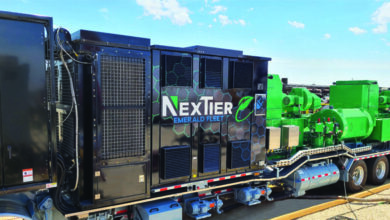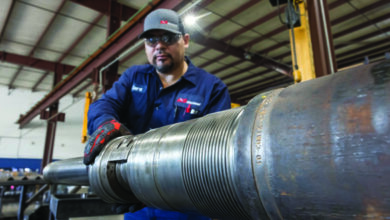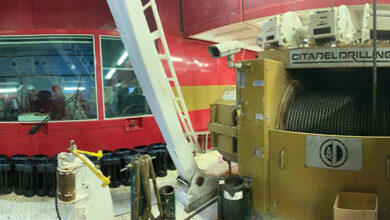Innovative solutions emerge to address one of hydraulic fracturing’s most critical concerns
By Katie Mazerov, contributing editor

As hydraulic fracturing enters a new phase in the current shale boom, the industry has learned a thing or two about the process, not the least of which is that it makes both economic and environmental sense to include the three R’s – reuse, recycle and reclaim – as part of the equation.
It takes three million to five million gallons of water to unlock the hydrocarbons of just one unconventional shale well. That, along with the costs associated with disposal, political pressure, and regulatory changes regarding disposal of fluids, has prompted operators large and small to take a look at their water recycling and reuse strategies.
In response, a variety of technologies have emerged onto the marketplace that allow producers to reuse their water, reduce transportation costs, comply with regulations and reduce their environmental footprint. Last year, Halliburton introduced a comprehensive water management system that meets the full range of customers’ needs, including water supply and storage, transportation, recycling, reuse and disposal. Baker Hughes has two mobile services designed to provide operators with convenient water treatment and drilling waste recycling in unconventional shale formations.
Innovation is coming from many sectors. “The operators themselves have pioneered approaches for water reuse that require a minimum amount of treatment,” said Keith Minnich, water sustainability manager for Calgary-based Talisman Energy. “But water treatment companies are now developing technologies that can accomplish virtually anything – even converting produced water to drinking water. Also, now that the major service companies have developed saline-tolerant additives, it is much easier to reuse produced water,” he said, noting that saline, a product of old sea water embedded in the shale, is no longer considered an operational problem.
Mr Minnich is involved in a joint industry project funded by the governments of Alberta and British Columbia to develop a methodology for the reuse of flowback water. The project is intended to provide operators, service companies and water treatment companies with a framework for evaluating what level of treatment is required for each type of fracturing fluid for a given situation.
“There are different types of hydraulic fracture treatments and different fluids involved in treatments,” he explained. “Some fluids are relatively simple and simple to use; others are more complex and require more treatment.”
The water treatment process for Talisman varies from play to play but has been primarily limited to simple suspended solids removal. The company has been able to reuse flowback and produced water with a minimum amount of treatment in the Marcellus play and the Montney gas field in British Columbia.
“Although the access to fresh water hasn’t been a limiting factor, we are committed to a responsible and sustainable water management strategy,” Mr Minnich said, noting that the Texas drought has caused some concern over the continued availability of fresh water in the Eagle Ford.
How Much Treatment?

Varying regulatory requirements have posed some difficulties, however. “Where we face some challenges is in the Marcellus play on what to do with the flowback water that cannot be reused. Pennsylvania does not have the same availability of injection wells as Texas, where excess flowback and produced water is commonly injected into deep wells.”
Pennsylvania also has put in place regulations that require water to be treated extensively prior to surface disposal, a costly undertaking. In Canada, surface discharge is not a given, and in Alberta the practice is banned no matter what level of treatment, Mr Minnich noted.
“The challenge everyone is facing right now is determining what level of treatment is actually required for reuse,” he continued. “Unnecessary amounts of treatment raise the cost and make it less attractive to reuse and also generate byproducts. The alignment of what treatment is required and what technologies are available is a work in progress.”
Among the entrepreneurial firms bringing high-tech solutions to the marketplace is Florida-based Ecosphere Technologies, which has developed and commercialized a technology that eliminates the need for oil and gas operators to use chemical biocides and scale inhibitors during hydraulic fracturing operations. Ecosphere’s patented Ozonix technology is an ozone-based, advanced oxidation process that combines ozone, hydro-dynamic cavitation, acoustic cavitation and electro-oxidation into one process to destroy bacteria and inhibit scale formation. Mobile, 53-ft units called Ozonix EF80s can process up to 80 bbls of frac water per minute.

Through its subsidiary, Ecosphere Energy Services, the company has treated and recycled nearly 30 million bbls of flowback water, produced water and surface water used as a makeup fluid. The technology can pre-treat raw water needed for hydraulic fracturing operations and post-treat flow-back and produced water at pond sites or fixed facilities, said Ecosphere Technologies chairman and CEO Charles Vinick.
“Typically, the operator brings produced or flowback water to a frac site and stores it in a reclamation pit or frac tanks,” Mr Vinick explained. “A water transfer company will then pump that water to us, along with surface waters from a nearby source.”
The water is blended by a proprietary mixing manifold and then treated with the Ozonix process. Once the water has gone through the system, the effluent water is discharged into a fracturing tank or manifold to be pulled into the pumping service company’s equipment, where it is blended with sand and ready to use as a fracturing fluid.

“We are treating water at the flow rate of the frac to eliminate the use of liquid chemicals,” said Robbie Cathey, CEO of Ecosphere Energy Services. “We also believe that by oxidizing organic material and precipitating salt compounds, we are improving the frac fluid’s compatibility with friction reducers, resulting in lower treating pressures.”
Ecosphere’s Ozonix technology has been used by Newfield Exploration in the Woodford play and Southwestern Energy in the Fayetteville over the last three years, and was deployed in the Eagle Ford and Permian Basin this year. The technology, which has been tested or used in all the major plays except the Bakken, can be applied in oil flood operations, enhanced oil recovery and wells producing condensate, Mr Vinick noted. “For operators, elimination of chemicals and recycling of water are key elements of a cost-effective and environmentally safe treatment system.”
An Electrifying Process

ROLCO Energy Services provides water management solutions for unconventional oil and gas producers using an electro-coagulation process that adds an electric charge to the water to convert dissolved solids such as iron, magnesium, calcium and naturally occurring radioactive materials into suspended solids that can be removed with a mechanical filter.
“By changing the polarity of the water, we are allowing dissolved particles to amalgamate and join together and become a suspended solid,” said CEO and founder Perry Roland. The company, founded in 2009, has worked in the Haynesville shale play and the Piceance Basin to treat water for reuse, and plans on entering the Bakken and Eagle Ford oil plays.
“We have figured out the key to do this successfully in the gas market, but the oil side brings some additional challenges, such as the constituents in the water,” Mr Roland said. “As operators continue to move rigs from the dry gas plays to the oil plays, our technology will follow.”

To that end, ROLCO is partnering with AbTech Industries, which has developed the Smart Sponge, an oil-absorbent material that removes hydrocarbons on the front end of the electro-coagulation process so they don’t enter the clean water system.
“The Smart Sponge is oleophilic, so it absorbs hydrocarbons that are in the water, but it is also hydrophobic, so it repels and doesn’t retain water,” said AbTech chief operating officer Jonathan Thatcher. “We manufacture it in a manner that retains very high flow rates through the media and results in little or no pressure loss. It can absorb one to two times its weight in hydrocarbons.”
The process solidifies the hydrocarbons it removes, creating a solid that can be burned as a fuel source in waste-to-energy facilities, cement kilns or incineration operations, Mr Thatcher explained. The water being treated is a combination of fracturing flowback water and produced water. It can be treated repeatedly, although the process may need to be modified because the water profile will change over time.
AbTech’s portable and installed units can process 10,000 bbls/day to 100,000 bbls/day of produced water. Often, there are multiple units on a fracturing site.

After the de-oiling process, a number of different technologies, including electro-coagulation, can be used to treat the water for a variety of uses. “The water can be treated to remove everything except brine for reuse in fracturing operations and can also be treated for discharge, which involves further removal of the salts and chlorides, typically by a reverse osmosis (RO) process for discharge into lakes or rivers. Pre-treatment is always required because other technologies, especially RO, can’t tolerate oil and grease coming into their systems,” Mr Thatcher explained.
Because a well will produce up to five times as much water as oil and gas over its life, some in the industry are eyeing water treatment systems as a potential source of water for agricultural purposes, provided all the salts are removed. “We could have a source of agricultural water that is not going to impact traditional drinking water sources such as lakes, rivers and underground aquifers,” Mr Thatcher said.
Reducing Truck Traffic

Another young company using electro-coagulation, Water Rescue Services Holdings, has been approved by the Texas Railroad Commission to operate a mobile recycling system in the state that allows operators to reuse produced and flowback water. The firm, launched in early 2011 in Fort Worth, is also planning to move into Wyoming, Louisiana and sections of the Marcellus.
Last September, the company signed a strategic alliance with Select Energy Services, an oil and gas services company, to provide a total water management system using Water Rescue’s patent-pending process.
In its mobile, 24-ft trailer, Water Rescue Services can process 600 gallons of water a minute, or 20,000 bbls in a 24-hr period, said Wes Williams, president of Water Rescue Services. “We get a sample of water from the operator with a directive of the water standard they need for their type of fracturing operation, such as slick water, hybrid or crosslink gel fracs,” he said. “We get the heavy metals, such as iron and suspended solids, out easily, but our customers may want other compounds out as well.”

In the electro-coagulation process, the metals surrender as the electric charge is placed on them, and the contaminants in the water bond together and drop into a settling tank. The water is then put through polishing filters before it is returned to the fracturing operation. Solids are compressed, de-watered and removed.
“For every 100 trucks the operator would have to send to a saltwater disposal well, we use three or four, depending on the play,” Mr Williams said. “We return 95% to 98% of the water to the facility, where it can be used again and again. In one play in south Texas, we will be able to keep an estimated 12,000 trucks off the road.”
The company says it has been contacted by government officials wanting to understand the process because they are receiving calls from their constituents about problems on the road.
“The oil and gas industry is going through a shift,” Mr Williams said. “In the past, water was plentiful, cheap and easy. Now water is like gold, and operators need to endorse new technologies to deal with water shortages and achieve high environmental standards. The recycling business is still in an embryonic stage, but companies like ours must prove our reliability to help the industry make recycling more of a necessity than a luxury.”
Ozonix is a registered term of Ecosphere Technologies





Ecosphere Technologies, Inc.’s Ozonix technology has processed over 1billion gallons of frac water to date. They recently signed an exclusive water treatment agreement with the Blackfeet Nation who’s lands sit atop the prolific Bakken Shale in Montana and borders Glacier National Park. Here is a link. http://m.rapidcityjournal.com/news/blackfeet-tribe-signs-with-company-to-treat-recycle-fracking-water/article_b58c5f30-78e1-11e1-9ef0-001871e3ce6c.html